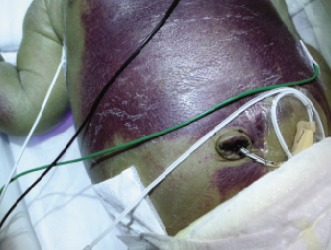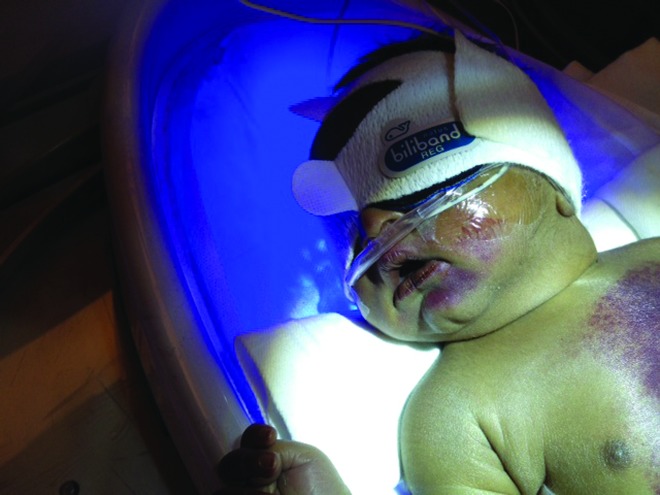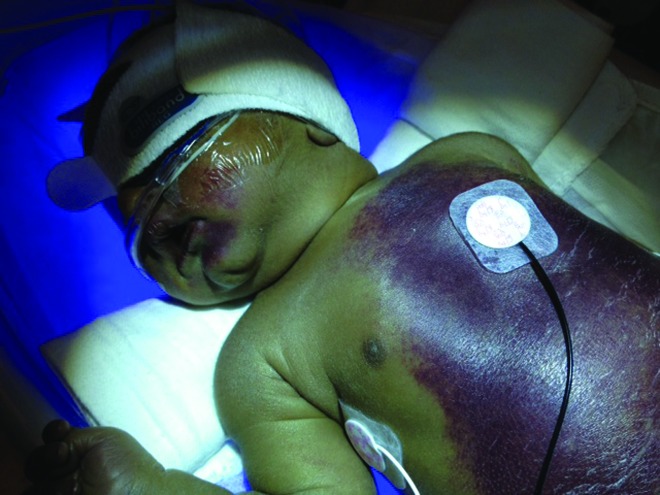Abstract
Phototherapy is commonly utilized in the treatment of neonatal jaundice. The authors observed a rare cutaneous complication of visible blue light phototherapy in a neonate with hyperbilirubinemia. A three-day-old neonate was evaluated for a purpuric rash after initiation of phototherapy for treatment of hyperbilirubinemia. Cutaneous examination revealed purpuric, nonblanching, well-demarcated lesions on the chest, abdomen, arms, and chin with sparing at shielded sites. The history, physical examination, and laboratory results support the diagnosis of purpuric phototherapy-induced eruption. The authors present a case report of this uncommon cutaneous eruption in a transfused neonate undergoing phototherapy for treatment of hemolytic disease of the newborn.
The treatment of choice for unconjugated (indirect) hyperbilirubinemia is visible blue light therapy. Although toxicity from phototherapy is rare, multiple cutaneous eruptions have been reported.1 In infants with cholestasis, a rare complication of phototherapy for neonatal jaundice is the bronze baby syndrome.1,2 Neonates with cholestatic jaundice who are receiving phototherapy may develop purpuric and bullous eruptions.3 Discord and severe blistering during phototherapy may signify congenital porphyria.1 Paller et al4 coined the term “purpuric phototherapy-induced eruption” in 1997 to describe a rare cutaneous complication of phototherapy in neonates with hyperbilirubinemia. All of the neonates received transfusions for hemolytic anemia prior to phototherapy. A blood transfusion was required in five of the six infants for erythroblastosis fetalis. In the sixth neonate, a twin-twin transfusion caused the hemolytic anemia. The photodistributed purpuric “raspberry”-induced eruption was noted at sites of exposure to the lights and spared shielded areas. Lesional skin biopsies revealed extravasated red blood cells, absent necrotic keratinocytes, and a sparse lymphocytic dermal infiltrate. An elevation in plasma porphyrins was noted in two patients. In all six neonates, the photodistributed eruption resolved spontaneously within one week after cessation of phototherapy. The authors speculate the feasibility of circulating porphyrins as the causative agent eliciting the skin rash. During follow-up periods ranging from four to six years, the patients developed no medical or cutaneous problems.4 The authors herein report a case of purpuric phototherapy-induced eruption in a transfused neonate.
CASE REPORT
A 3,150g boy was born after 34 weeks 5 days gestation to a 38-year-old B-negative mother via Cesarean section. Complications during pregnancy included gestational diabetes, Rh isoimmunization, and premature rupture of membranes. Two exchange fetal transfusions were performed in utero prior to delivery. The infant was severely jaundiced at birth and large for gestational age with initial hemoglobin of 5.5g%, hematocrit 16.9%, reticulocyte count of 24%, and platelet count of 72,000. Apgar scores at one and five minutes were eight and nine, respectively. The infant’s blood type was determined to be B-positive. Cord total bilirubin was 15.3mg/dL with a direct level of 2.3mg/dL and exhibited Coombs-positivity.
By 12 hours of life, the total bilirubin level increased to 17.5mg/dL. A double volume exchange transfusion was performed. The neonate was administered immunoglobulin G (IgG) antibodies, phenobarbital, and intense phototherapy. As a result of severe thrombocytopenia, the neonate received two platelet transfusions. Despite these therapeutic modalities, total bilirubin levels continued to elevate to 20.2mg/dL with a direct level of 14.4mg/dL. A pediatric gastroenterologist diagnosed the neonate with severe hyperbilirubinemia and cholestasis, both secondary to hemolytic disease of the newborn from Rh incompatibility. Abdominal ultrasound confirmed a normal appearance of the liver, spleen, and gallbladder. Serum transaminases were stable. On Day 4 of life, the authors were consulted to evaluate a rash that began at three days of age. A striking, well-demarcated violaceous and purpuric nonblanching eruption was noted on the anterior trunk, hands, and part of the chin (Figures 1-4). Distinctly, the purpuric patches were limited to areas of phototherapy and absent at sites of leads and dressings. There was no evidence of vesicles, bullae, erosions, or skin fragility. The skin lesions appeared asymptomatic since the neonate did not spontaneously recoil upon palpation. Permission for a skin biopsy was denied. Serum porphyrins were measured at ARUP laboratories (Associated Regional and University Pathologist, Salt Lake City, Utah). Total serum porphyrin level was 19nmol/L (normal reference interval 0-15nmol/L). A significant improvement in purpuric areas on the hands and the chin were appreciated one day after discontinuation of phototherapy. Complete cutaneous resolution occurred seven days later.
Figure 2.
Purpuric eruption of chin. Note absence of cutaneous lesions underlying tape and nasal cannula.
Figure 3.

Purpuric patches on anterior trunk. Note complete sparing of areas underlying monitor leads.
Figure 1.
Purpuric nonblanching eruption on exposed sites after phototherapy.
DISCUSSION
The management of choice for unconjugated (indirect) hyperbilirubinemia is visible light therapy.5 The therapeutic absorption of bilirubin occurs optimally in the blue range of the spectrum.1 Wavelengths in the range of 460 to 490nm change the structure of unconjugated bilirubin in the skin and modify it to molecules that can be excreted in bile or urine.1 While consequential toxicity from phototherapy is infrequent, reports of systemic adverse effects include a change in the infant’s thermal environment (overheating), dehydration, electrolyte disturbance (hypocalcemia), conjunctivitis, and retinal damage.6 Long-term sequelae of neonatal phototherapy include an increase in melanocytic nevi, childhood asthma, allergic rhinitis, and patent ductus arteriosus.6 Cutaneous complications are rare, but have been reported. The bronze baby syndrome bullous eruptions and purpura have all occurred in neonates receiving phototherapy for treatment of indirect hyperbilirubinemia.1-4,7 The authors present a case report of purpuric phototherapy-induced eruption in a transfused neonate. This benign, but distinct, complication was originally reported by Paller et al.4 A second similar report was published in 2011. This neonate also had hemolytic disease of the newborn, received intravenous immunoglobulin, and subsequently developed a purpuric eruption after visible light therapy.7 To the authors’ knowledge, this case is the third proclaimed case report in the literature. Similar to the cases reported by Paller4 and Tuerk,7 the differentiating clinical characteristics of the cutaneous eruption are confinement of purpura to sites neighboring the phototherapy lamps, exemption of sites shielded from phototherapy exposure, inability to blanch on palpation, and spontaneous resolution of the outbreak with cessation of phototherapy. Comparatively, the authors’ neonate developed hemolytic anemia from erythroblastosis fetalis and received an exchange transfusion prior to phototherapy.5 It has been postulated that circulating porphyrins are the causative factors in the mechanism of phototherapy purpura.1,4,7,8 Analogous to the cases in Paller’s study, there was an increase in the total serum porphyrins during the cutaneous eruption. The cause of the elevated serum porphyrins is uncertain. The maximum absorption of light by porphyrins occurs in the Soret band with a maximum absorption peak between 400 and 410nm.9 Photoactivated porphyrins stimulate photodamage via reactive oxygen species and free radicals.9 Clinically, the majority of the cutaneous porphyrias demonstrate blistering, which occurs by accumulation of water-soluble porphyrins.3,8,9 Conceivably, hepatic cholestasis may have been a contributing factor to the increase in serum porphyrins. The direct bilirubin was elevated in the patient described herein and in two patients in the Paller study. Paller suggested an improbable, but conceivable, origin of circulating porphyrins may be through the hemolysis of young erythrocyte precursors, such as reticulocytes.4 These immature precursors harbor a tenfold higher concentration of porphyrins than do mature erythrocytes.8
An additional possibility may be the effect of intravenous Ig on circulating porphyrins or some unknown interaction in some infants, but not others. To the authors’ knowledge, the first case of purpuric phototherapy-induced eruption in transfused neonates occurred in 1997. Management of hemolytic disease of the newborn with intravenous gammaglobulin began in the early nineties.10 Thus, there were no reports describing this cutaneous complication after initiation of visible light therapy prior to 1997. We must consider the feasibility that intravenous gammaglobulin may play a role in the purpuric eruption induced by phototherapy in transfused neonates.
CONCLUSION
The authors describe the third case report in the literature of “purpuric phototherapy-induced eruption.” The astute physician may fail to recognize this entity due to the scarcity of descriptions and case reports. The authors report this rare complication of phototherapy in transfused neonates to help familiarize providers with this entity. Immediate recognition of this striking cutaneous eruption will avoid unnecessary medical measures and promote parental reassurance. Purpuric light eruption should be considered in the differential diagnosis when evaluating a cutaneous eruption in transfused neonates who undergo phototherapy. Detailed analysis of serum porphyrins or intravenous gammaglobulin in subsequently affected neonates may aid in clarifying the mechanism of this striking purpuric eruption.
Footnotes
DISCLOSURE:The authors report no relevant conflicts of interest.
REFERENCES
- 1.Maisels MJ, McDonagh AF. Phototherapy for neonatal jaundice. N Engl J Med. 2008;358:920–928. doi: 10.1056/NEJMct0708376. [DOI] [PubMed] [Google Scholar]
- 2.McDonagh AF. Bilirubin, copper-porphyrins, and the bronze baby syndrome. J Pediatr. 2011;158:160–164. doi: 10.1016/j.jpeds.2010.08.014. [DOI] [PubMed] [Google Scholar]
- 3.Mallon E, Wojnarowska F, Hope P, Elder G. Neonatal bullous eruption as a result of transient porphyrinemia in a premature infant with hemolytic disease of the newborn. J Am Acad Dermatol. 1995;33:333–336. doi: 10.1016/0190-9622(95)91428-5. [DOI] [PubMed] [Google Scholar]
- 4.Paller AS, Eramo LR, Farrell EE, et al. Purpuric phototherapy-induced eruption in transfused neonates: relation to transient porphyrinemia. Pediatrics. 1997;100:360–364. doi: 10.1542/peds.100.3.360. [DOI] [PubMed] [Google Scholar]
- 5.Schwartz HP, Haberman BE, Ruddy RM. Hyperbilirubinemia: current guidelines and emerging therapies. Pediatr Emerg Care. 2011;9:884–889. doi: 10.1097/PEC.0b013e31822c9b4c. [DOI] [PubMed] [Google Scholar]
- 6.Xiong T, Qu Y, Cambier S, Mu D. The side effects of phototherapy for neonatal jaundice: what do we know? What should we do? Eur J Pediatr. 2011;170:1247–1255. doi: 10.1007/s00431-011-1454-1. [DOI] [PubMed] [Google Scholar]
- 7.Tuerk MJ, Konia Th, Lamb PM. Part III: phototherapy- induced purpura in the setting of transient porphyrinemia in a neonate. J Drugs Dermatol. 2011;10:306–307. [PubMed] [Google Scholar]
- 8.Crawford RI, Lawlor ER, Wadsworth LD, Prendiville JS. Transient erythroporphyria of infancy. J Am Acad Dermatol. 1996;35:833–834. doi: 10.1016/s0190-9622(96)90096-1. [DOI] [PubMed] [Google Scholar]
- 9.Frank J, Porphyria Poblete-Gutierrez. Dermatology, 2nd ed. In: Bolognia JL, Jorizzo JL, Rapini RP, editors. Elsevier; 2008. pp. 641–652. [Google Scholar]
- 10.Rubo J, Albrecht K, Lasch P, et al. High-dose intravenous immune globulin therapy for hyperbilirubinemia caused by Rh hemolytic disease. J Pediatr. 1992;121:93–97. doi: 10.1016/s0022-3476(05)82551-x. [DOI] [PubMed] [Google Scholar]




